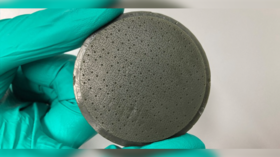Researchers create first ever artificial HUMAN TONGUE in latest 3D printing breakthrough

A multidisciplinary team has 3D-printed a replica of the human tongue, complete with synthetic soft surfaces and tongue-like textures, which may lead to a domino effect of breakthroughs in a variety of research fields.
Scientists led by the University of Leeds, in collaboration with University of Edinburgh, have meticulously replicated the surface of the human tongue which plays a critical role in how we taste food, how we speak, swallow and absorb nutrients, among other functions.
The biomimetic tongue accurately mimics the topology, elasticity and “wettability” – how a liquid keeps contact and spreads across a surface – of the human tongue, the scientists claim.
Also on rt.com Lego for bones? Scientists develop method for repairing fractures using 3D-printed bricks inspired by popular toyThe synthetic silicone structure could play a game-changing role in screening new oral technologies, while also improving nutritional technologies, pharmaceuticals and dry mouth therapies (some 10 percent of the general population suffers from dry mouth).
The team, comprising food scientists, experts in soft matter physics, dentistry, mechanical engineering as well as computer science, focused on the anterior dorsal section (roughly the middle of the visible tongue, after the tip but before the base).
This area is partially covered in some papillae (the little divots dotted across the tongue) which contain taste receptors, though not all act as taste receptors. The team took moulds of the tongue surfaces from 15 adult participants.
Also on rt.com Sex cells: Scientists have been wrong for 350 years about how sperm swim – here’s what’s really going on“Hundreds of small bud-like structures called papillae give the tongue its characteristic rough texture that in combination to the soft nature of the tissue create a complicated landscape from a mechanical perspective,” said lead author, Dr. Efren Andablo-Reyes, who described the work as a “unique architectural challenge.”
These impressions were then 3D optically scanned to map the dimensions of the papillae on the surface, as well as their density and the average overall roughness of human tongues. The texture was found to closely resemble a randomized layout.
Scientists led by @FoodSciLeeds have 3D printed the first ever biomimetic tongue surface, opening new possibilities for helping with food safety by detecting counterfeits, developing nutritional technologies, pharmaceutics, and dry mouth therapies.https://t.co/5tOhJ95QMtpic.twitter.com/31cGPjVUS2
— University of Leeds (@UniversityLeeds) October 27, 2020
Think your friends would be interested? Share this story!













